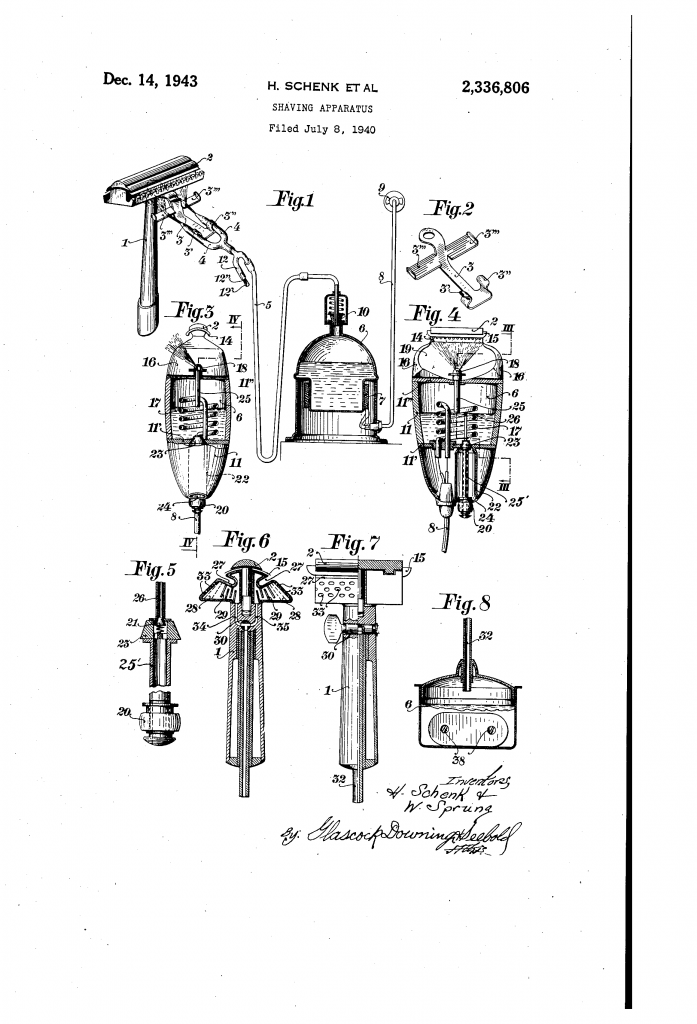The word “apparatus” makes me think of something big, complex, and of dubious use. I mean, if it was something simple and useful, we wouldn’t use a fifty dollar word to describe it, right? So it is only right and proper that Hans Schenk and Walter Sprung termed their patent application for their invention that way. It is, indeed, a shaving apparatus.
An overly complex and perhaps a tad bit scary piece of gadgetry. A – in my opinion – contraption of dubious value. With the added benefit of risking scalding the shaver.
So what was their invention? What imaginary problem were they trying to fix? Well, in their own words from the introduction to the patent:
The invention relates to a shaving apparatus to enable in a simple manner a considerable improvement of the shaving as regards rapidity and convenience. In the past the beard has been treated in a comparatively complicated manner by the application of liquid and soap and brushed or rubbed until the desired beard softening effect was attained. The shaving was then carried out in the usual manner.
From US patent 2,336,806
The invention has for its object to simplify this procedure in that the shaving apparatus, that is a safety razor, is combined with a steam producer from which steam flows adjacent the blade of the razor, so that the portion of the skin in the path of the razor is subjected to a steam treatment before the razor blade comes into contact with the skin. No other preparatory treatment of the portion of the skin to be shaved is necessary.
So… where even to begin? The fallacy that using a brush to apply lather is comparatively complicated1? The mistaken idea of blowing steam straight against the face? Or the weird and wonderful ways Hans and Walter wanted to achieve a smoother, simpler scalding shave?
The later sounds more fun. Lets do that.
The idea of adding heat to the shave wasn’t new, but these designs are the first I’ve seen that uses steam to do it instead of just burning or electrocuting you. I guess that is an improvement?

Figures one and two of the drawing shows how the invention could be adapted for a regular razor. A carrier plate held two steam nozzles and directed the steam just in front of the safety bar of the razor. The nozzles were connected to a steam generator3 by a flexible hose – because nothing says convenience like a long hose attached to your razor. And what can be less relaxing than risking pulling an electric kettle of the vanity in the morning? At least they included a way to get condensed water out of the steam pipe.4
As scary as using their shaving apparatus as an attachment for a regular razor sounds, the purpose made steam razors cranks the horror up a notch. Or ten. To be honest, the scale goes up to eleven on this one.
In figures three and four, we can see a handy handheld torture shaving device. Just how handy it is can be judged by how small the handle is compared to the razor head5… or rather, how small the razor head is compared to the handle. And the handle had to be a hefty hunk, considering that it contained a few odds and ends. It had an electrical coil heater. It had a filler cap with a built in safety valve.6 It had insulated walls. And it had a nozzle to direct scalding hot steam directly into the users face. The whole caboodle was described as “a handy aggregate”. I’m not sure I agree with that description.
The last three figures shows a shaving apparatus that combines the horrors of the two first. It had a specially designed razor and razor head. It had an external steam producer,7 connected to the razor by a flexible hose. The handle is chunky, although significantly less so than the second variation. It adds a complication by the inclusion of a three way cock – thus letting the user choose which side8 of the razor the scalding steam should escape from. This version did do away with the steam nozzle though. Instead it had a complex system of internal baffles9 that directed the steam to a series of nozzles. The nozzles made sure to “gently” steam the beard. And skin. And flesh, if the shaver wasn’t fast enough.
The patent is, as most of the patents I bring up, long expired. So while it is free for the taking, I don’t think that even Gillette would consider marketing a razor that blasted the user with hot steam. The idea is, quite honest, bonkers. Because, when all is said and done, who would consider the comparatively complicated task of making and applying lather to be worse than scalding one’s face with every shave?
The full patent can be read at Google Patents. If you enjoy old and odd shaving related patents, why not check out some of my other posts on the subject?
Footnotes:
- It ain’t – I can lather up without being properly awake.
- Which, by definition, is boiling hot.
- At leas the boiler included a safety valve, making a steam explosion less likely.
- See items labelled 12, 12′, and 12” in figure one.
- You might have to look closer – it is labelled 2 in the drawing.
- As shown in more detail in figure five.
- That looks very different than the one depicted for the first iteration of the shaving apparatus, and is not shown with a safety valve.
- Or both at the same time.
- Labelled 29 on the drawings.

Pingback: Shaving apparatus - Razors n Blades the shave that saves
Pingback: Safety razor with fluid distributing manifold - Wegian WetshavingWegian Wetshaving